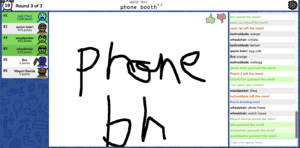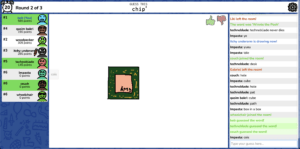Basic info
I played skribble.io, an website-based party game where players take turns drawing a word and the other players seeing who can guess the word first. The creators seem to be anonymous.
Target audience
It seems to target younger audiences, such as elementary and middle school kids, which can be seen from everything from the vibrant UI colors, sketchy and messy art/logo style, heavy use of rounded fonts, to the avatar customization (which kids certainly like to do, though adults might like to as well), and ease of access of joining a public lobby with the click of a button (kids are presumably not very good at following complex instructions).
Since it is a social game, the other way to approach looking at the target audience is by guessing the age of people in some lobbies you play by their interactions. I encountered some (hopefully accurate) telltale signs of young age, including misspelling words and misunderstanding what their word means when it’s their turn to draw.

Pictured: Someone who gave up trying to draw the object, tried to write out “phone booth”, and then began to spell it as “phone bh…”
Of course, on the other side of the spectrum there are also people who are very capable of understanding word meanings, and some level of game strategy. For example, as the drawer, you want as many people to guess your word to maximize your score without directly writing out your word (since that tends to get you kicked), so simple and intuitive drawings are great.

Pictured: Someone who clearly understands some things about the world beyond the knowledge of a 5 year old (I’m assuming the only chips 5 year olds get exposed to are potato chips).
Formal elements
The game can be played by anywhere between 2 and 8 players, though it seems like the more players the more entertaining it is. This is because the drawing is not the only, or in some cases, not even the main source of information for guessing the word—there is also an indicator for the number of letters, hints that reveal single letters over time, as well as being able to see other players’ guesses in the chat.
This last aspect can become especially useful if in a lobby of players who are poor at spelling—if another player guesses the right word but spells it wrong, then it is revealed to you, and you can fix their spelling to score! Even without such extreme cases, other players’ guesses can often serve as inspiration for what categories of objects you are guessing. Hence, the more players, the more fun.
The flip side of that is being the drawer is a different type of fun, so if there are too many players, it takes too long to cycle to you to become the drawer, so a balance of max 8 players seems like a good choice.
I’m assuming the reader is familiar with skribble.io so I won’t describe any more of the game mechanics.
Vulnerability
On the face of the game, there’s not much room to become vulnerable. Firstly, it’s an online game where everyone is anonymous, so there’s no fear of revealing anything that could be traced back to your identity. However, just because everyone is anonymous doesn’t mean that there aren’t a host of social pressures, whether expressed or internally felt.
When you are the drawer, there is an interesting social dynamic between you and everyone else—you can feel that all the players are intensely trying to read what’s in your mind. At least for me, I feel a certain responsibility to satisfy their desire, by drawing a nice and comprehendible picture. I also get a certain weird type of joy when players do manage to guess my word, like we have developed a shared understanding over something as a result of my way of expressing the concept. I imagine it’s similar to the joy a teacher would get when their student finally understands a concept.
The flip side of that is that all the players are simultaneously judging you, not so much for your drawing abilities but for your ability to communicate clearly and convey concepts, albeit in this weird pictorial manner. If you cop out, such as by writing the word (like in Picture 1), there’s clearly something wrong with your understanding of the word or your ability to draw it (says your mind to yourself). In the top right corner, there are thumbs up and down buttons, which have no functional purpose but can be used to express judgement of the drawing. The social approval you can get from making a good drawing is also a source of joy.
But then again, the primary target audience is kids, and perhaps younger kids feel social pressures in very different ways than I would observe as a playtester.



